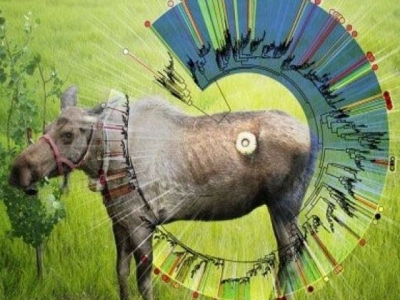Can moose digesta help inform ruminant nutrition?

First-of-a-kind study advances understanding of microbial and viral communities involved in ruminant biomass breakdown.
A research team is advancing understanding of how microbial communities function in the wild, by studying rumen of live moose foraging in the field.
Microbes in the gastrointestinal tract of moose and other ruminants help break down tough plant materials such as bark, woody stems and cellulose into carbon nutrients.
An international research team now has gained a more holistic view of a complex microbial food web that is responsible for carbon processing in the natural rumen ecosystem of wild moose. According to an announcement from the U.S. Department of Energy's Office of Science, the team's efforts deciphered community structure and metabolic handoffs underpinning this animal hosted microbial ecosystem.
Microbes breaking down biomass play a vital role in a surprising number of processes. These processes determine, for example, if a useful biofuel or bioproduct can be formed. According to the announcement, this research explains how microbes process woody material like twigs and bark in the guts of moose and helps scientists predict how seasonal dietary changes affect a moose's ability to break down woody materials.
While previous studies used hunter-killed animals, this study sampled live, free-ranging Alaska moose grazing in the wild. By equipping these moose with rumen fistula — much like what is done in dairy and beef cattle nutrition studies — the team could sample the animals as they digested a natural diet.
The effort provided first-of-its-kind access to the microbial communities residing in the rumen of these animals as communities actively degraded woody plant biomass during spring, summer and winter foraging months.
The research team was from The Ohio State University, the University of Alaska Anchorage, the Norwegian University of Life Sciences, the University of Copenhagen in Denmark, Newcastle University in the U.K., the Pacific Northwest National Laboratory (part of the U.S. Department of Energy) and the Alaska Department of Fish & Game.
The work made use of protein and metabolite data gathered using 600 MHz nuclear magnetic resonance spectroscopy at the Environmental Molecular Sciences Laboratory and genomic data obtained from the Joint Genome Institute.
Studying such rich data in combination with state-of-the-art enzymology gave researchers a glimpse into how microbes are specialized and how they coordinate their tasks to mediate the overall “flow” of carbon within the rumen, the announcement said.
The analysis enabled metabolic insights into 180 genomes, most of which were previously unknown, and addressed the underappreciated influence that viruses exert in ruminant digestion, the researchers said. The findings are relevant to agriculture, human health and biofuel production, the announcement said.
The study was published in the journal Nature Microbiology.
Related news
 Livestock chain analyses help predict disease spread
Livestock chain analyses help predict disease spread Livestock transportation chains are often very complex, and that complexity expands the larger the industry segment is, making understanding the contact chains
 Uruguay: Fresh forage and TMR mixed diets may be cheaper, support high milk yield
Uruguay: Fresh forage and TMR mixed diets may be cheaper, support high milk yield Adding set amounts of fresh forage to dairy cow diets may provide cheaper feed, support high milk production and add desirable fatty acids to milk composition
 Winning the battle against heat stress starts with nutrition
Winning the battle against heat stress starts with nutrition On-farm protocols aren’t the only things keeping your cows cool. The right nutritional solutions can play a big role in mitigating the effects of heat stress.